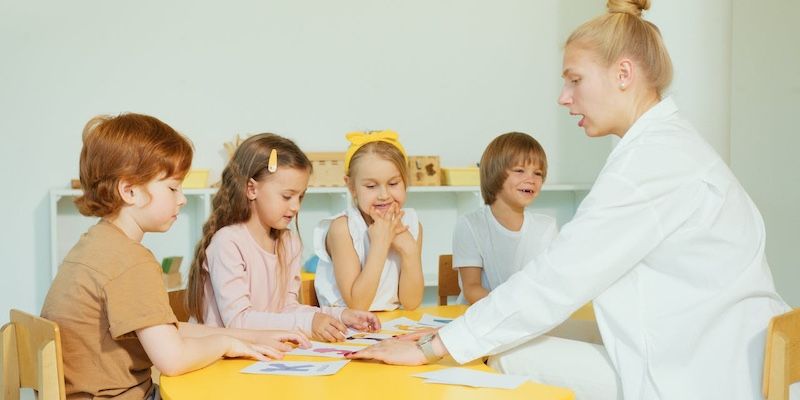Positive Youth Development: Best Activities & Training Programs

Investing in our young people is a wise but seemingly daunting undertaking. Positive youth development encompasses research-driven practices that have proven to be effective in building skills in teens.
What do these programs look like and what traits do effective positive youth develop programs have? Read on to explore more about this fascinating framework.
Before you continue, we thought you might like to download our three Goal Achievement Exercises for free. These detailed, science-based exercises will help the youth in your programs create actionable goals and master techniques to create lasting behavior change.
This Article Contains:
- What is Positive Youth Development?
- Framework, Models and Theories Explained
- 5 Examples of Successful Programs
- 3 Activities and Strategies For Your Program
- Assessment Tools: 2 Questionnaires and Inventories
- 6 Training Programs, Certifications and Online Options
- A Look At Our Positive Psychology Resources
- A Take-Home Message
- References
What is Positive Youth Development?
Positive youth development (PYD) is about valuing young people as members of society and giving them the skills, voice, and opportunities to contribute to society. PYD is a somewhat recent approach to youth research and practice. Formally conceived in the early 1990s, it is an alternative approach to reducing problem behaviors in youth (Nystrom, Prata, & Ramowski, 2008).
Like positive psychology, positive youth development encompasses a strengths-based approach where skills are fostered. This is contrary to a deficit-driven perspective where concerns are addressed. In other words, this theory is more or less preventative in nature.
As opposed to being an assessment of anything and everything that appears to be advantageous for young people, it is instead a collection of best practices for working with youth. PYD can also be described as an
“approach with strong defining assumptions about what is important to look at if we are to accurately capture the full potential of all young people to learn and thrive in the diverse settings where they live.”
Damon, 2004, abstract
Positive youth development promotes resilience and bonding; social, emotional, cognitive, behavioral, and moral competence; and self-determination, self-efficacy, and positive identity development among children, adolescents, and young adults (Dimitrova & Wiium, 2021).
PYD subscribes to the growth mindset theory, involving the plasticity of human development. This means that youth’s skills and abilities can be developed and improved over time.
5 Principles of positive youth development
- PYD is a strengths-based framework (Yuen et al., 2022). Instead of focusing on concerns youth may have to face and the challenges they may be required to overcome, PYD aims to develop important skills necessary for adulthood.
- PYD revolves around research-based practices that have proven to be effective (Romer & Hansen, 2021). Instead of haphazardly executing practices, PYD involves the intentional implementation of practices that have demonstrated success in similar programs.
- Positive environments, positive experiences, and positive relationships are essential to human flourishing; however, they are particularly important for developing youth. Ensuring that young adults have access to programs where they can anticipate positive environments, experiences, and relationships is essential for effective PYD programs (Hamilton et al., 2004).
- Considering Maslow’s Hierarchy of Needs, physiological and safety needs must be met prior to addressing other elements such as needs of belonging, self-actualization, and self-esteem. PYD operates under the same premise where youth directors understand young people require basic physiological and safety needs to be met before tackling some of the more difficult agents in young adulthood (Thorn, 2021; Wallace, 2021).
- PYD programs should involve youth voice (Lindsay et al., 2021). Involving these benefactors’ perspectives helps to present relevant and effective opportunities that build vital skills. Allowing youth to contribute will help to ensure acceptance and a willingness to take part in the program.
Why is positive youth development important?
It goes without saying that by valuing youth today, we are molding the leaders of tomorrow and investing in our future. Adolescence is a time of growth physically, cognitively, mentally, emotionally, and socially and is one of the most important developmental periods (Mihić et al., 2022).
Youth will develop no matter the environment they are in; however, employing PYD enables youth to prosper. This paradigm places young people’s needs central to the program in which they are involved.
Framework, Models and Theories Explained
“Within the PYD framework, developmental success represents progress towards becoming a fully functioning adult with the abilities and competencies to reach one’s potential while also contributing to the welfare of the community.”
Romer & Hansen, 2021, p. 75-76
Many times, a successful PYD model may include:
- Ensuring physical and psychological safety
- Appropriate structure
- Supportive relationships
- Opportunities to belong
- Positive social norms
- Support for efficacy and mattering
- Opportunities for skill building
- Integration of family, school, and community efforts (Hamilton et al., 2004).
Often you will come across the 7Cs model in much of PYD literature. PYD programs should address these elements in order to ensure quality programming.
The 7Cs consist of (Hamilton et al., 2004; Wallace, 2021):
- Competence
- Confidence
- Character
- Caring
- Connection
- Contribution
- Creativity
PYD programs features also typically include (Lindsay et al., 2021):
- Skill building
- Youth engagement and contribution
- Healthy relationships and bonding
- Belonging and membership
- Positive norms, expectations, and perceptions
- A safe space
- Access to age-appropriate and youth-friendly services and integration among services
5 Examples of Successful Programs

4-H Program
If leadership skills are something your youth is interested in while addressing the principles of PYD, this program is for them (Allen & Lohman, 2016; Wallace, 2021).
Reaching six million kids and teens, the 4-H program is America’s largest youth development organization. The youth involved with this program complete hands-on projects in areas such as science, health, agriculture and civic engagement.
All 4-H programs include mentoring and career readiness as central elements. Find out more about this amazing opportunity on their website.
Restorative practice
Contrary to exclusionary methods of discipline, restorative practices in schools help to establish a tolerant, respectful, and supportive environment among students and staff (Morgan, 2021).
In an attempt to decrease suspension rates, six elementary and middle schools in Texas implemented a restorative discipline program. They found this approach to be effective, and in-school suspensions reduced by 70% as well as a 77% reduction in out-of-school suspensions (Morgan, 2021).
Dream School Program
The Dream School Program in Norway has shown success in the realm of PYD (Dimitrova & Wiium, 2021; Larsen & Holsen, 2021).
This program is based on peer mentorship where students developed leadership and social skills throughout the school environment, and also expressed experiencing positive feelings while helping other students (Larsen & Holsen, 2021).
This research illustrates the importance of valuing student voice, and using those voices as resources for a positive school climate.
Religion
Like adults, religion can serve as an activator for better mental health and help to create a sense of belonging. Likewise, religion helps to facilitate better youth development (De Guzman & Vajner, 2021).
In fact, research in the U.S. demonstrates a strong connection between individuals who have a strong commitment to religion to civic engagement (Ozalp & Ćufurović, 2021). Not all youth may be interested in an organized religion and this is ok. In this case, adults may want to encourage a feeling of connection in other ways.
Sports
Organized sports and sports-based interventions are effective strategies for positive youth development. Sport participation has been shown to impact youth development outcomes positively (Bruner et al., 2021).
Advantages of sports may include psychosocial and mental health benefits and individual growth across physical, cognitive, and social domains.
3 Activities and Strategies For Your Program
“Participation in high quality, structured activities outside of school can situate youth in safe environments, prevent youth from participating in delinquent activities, teach youth general and specific skills, beliefs, and behaviors, and provide youth opportunities to develop relationships with peers and mentors.”
Allen & Lohman, 2016, p. 2
Family involvement
Family participation is critical, as family variables are some of the most influential contextual factors in predicting youth development (Orejudo et al., 2022).
Parents are a child’s first teacher and to say that they are influential is an understatement. Involving families in a PYD program strengthens not only the family unit, but the program as well.
Social emotional learning
Explicit social and emotional learning (SEL) is advantageous for everyone, particularly youth, as they may not have been taught or have had the opportunity to practice these skills.
Schools frequently rely on punitive measures such as suspensions, expulsions, and police; however, school counselors, social-emotional learning specialists, and social workers used to address mental health issues would be a more appropriate solution (Prins et al., 2022).
Service learning
Integrating community service with academic learning, service learning is a type of pedagogy that applies a “learning by doing” practice. Youth engagement in service learning showcases their talents and promotes PYD.
Positive outcomes of service learning include fostering students’ intellectual development, personal development, civic development, and other social attitudes (Lin & Shek, 2021).
Assessment Tools: 2 Questionnaires and Inventories

This yes/no questionnaire examines your organization’s alignment with the mission and promotion of positive experiences, relationships, and environments of PYD.
Access the Assessing Your Organization’s Readiness for Positive Youth Development here.
YouthPower offers a Positive Youth Development Measurement Toolkit. This inventory helps youth-focused programs to evaluate their practices. Access this toolkit for free here.
6 Training Programs, Certifications and Online Options
ACT for Youth provides an engaging twelve-hour curriculum that includes the training manual, activity worksheets, handouts, slides, pre- and post-tests, and a feedback form. Download the curriculum for free from their website.
PYD 101 Online Courses also offered by ACT for Youth is an interactive collection of online courses where you can earn a certificate of completion for your work. Six 30-minute courses are offered and are ideal for new youth work professionals, volunteers, and advocates. Find more information and register for free here.
If you have already taken the PYD 101 course and are hungry for more, you will want to explore the PYD201 course offering. Register for this course here.
Colorado is a state in the U.S. that is at the forefront of PYD and the Colorado Department of Public Health and Environment (CDPHE) has created a regional PYD Training System. Training is free and you can register for a specific date here. Lunch is even provided!
The Maine Youth Action Network also offers professional development concerning PYD. Past training descriptions can be viewed here; however, check back periodically for upcoming PYD training.
The University of Minnesota offers a course based on the work of Eccles and Gootman (2002). Sessions for this program include Supportive Relationships with Caring Adults, Creating Opportunities to Belong, and Developing Positive Social Norms, among others. Enroll in their course here.
A Look At Our Positive Psychology Resources
Created by a team of experts, in collaboration with the world’s top universities, organizations, and researchers, the Positive Psychology Toolkit© contains over 400 exercises, activities, interventions, questionnaires, and assessments and is the world’s largest online positive psychology resource.
Some of the exercises that would be valuable for developing youth is Teaching a growth mindset as well as Internalized motivation in the classroom.
Besides this valuable collection of tools, this free worksheet about Goal Setting for Self-Esteem can be particularly helpful. It encourages students to do self-reflection, and goal setting to improve themselves.
With today’s prevalence of bullying and school violence, it is essential to encourage students to consider other perspectives. This Conflict at School worksheet forces students to look at their emotions, what upsets them, and what it is they need from a situation.
Once they are able to better identify what upsets them and what they need from others, it is a good idea to reverse the exercise. Teach kids to reflect on their own actions, or lack of action, and how this could cause conflict with others.
Additional reading
The following articles are also highly applicable to developing our kids to be the best adults they can be:
- What is Positive Education, and How Can We Apply it?
- A Look at Educational Coaching in the Classroom
- Building Intrinsic Motivation in Students: 29 Classroom Tools
- Applying Positive Psychology in Schools & Education: Your Ultimate Guide
If you’re looking for more science-based ways to help others reach their goals, this collection contains 17 validated motivation & goals-achievement tools for practitioners. Use them to help others turn their dreams into reality by applying the latest science-based behavioral change techniques.
A Take-Home Message
Adolescence is a difficult enough time. Today’s youth face even more challenges than adolescents experienced ten or twenty years ago. Pair the current difficulties with technology with risk behaviors that have historically challenged youth, such as peer violence, tobacco, alcohol, sexual risk, illicit substance use, and gambling (Mihić et al., 2022), today’s youngsters are up against giants.
This is where PYD comes into play.
Not only can PYD prevent some difficulties many youth face, it addresses basic human needs and can help to mold adolescents into productive members of society. Skills such as resilience, leadership, kindness, conflict resolution, compassion, social and emotional problem-solving, and goal setting are fostered within PYD and help youth transition into adulthood.
So here’s to equipping our youth with the tools they need to not only face the giants, but to thrive in an environment that values their perspective and has their best interest at heart.
We hope you enjoyed reading this article. Don’t forget to download our three Goal Achievement Exercises for free.
- Allen, B. S., & Lohman, B. J. (2016). Positive youth development life skills gained at the Iowa 4-H youth conference. Journal of Youth Development, 11(1), 62-76.
- Bruner, M. W., McLaren, C. D., Sutcliffe, J. T., Gardner, L. A., Lubans, D. R., Smith, J. J., & Vella, S. A. (2021). The effect of sport-based interventions on positive youth development: A systematic review and meta-analysis. International Review of Sport and Exercise Psychology, 1-28.
- Damon, W. (2004). What is positive youth development?. The Annals of the American Academy of Political and Social Science, 591(1), 13-24.
- De Guzman, M. C., & Vajner, D. (2021). Religion associated with strong positive youth development In North Carolina county. Journal of Student Research, 10(2).
- Dimitrova, R., & Wiium, N. (Eds.). (2021). Handbook of positive youth development: Advancing research, policy, and practice in global contexts. Cham, Switzerland: Springer.
- Eccles, J., & Gootman, J. A. (Eds.). (2002). Community programs to promote youth development. Committee on community-level pro- grams for youth. Washington: National Academy Press.
- Hamilton, S. F., Hamilton, M. A., & Pittman, K. (2004) Principles for Youth Development. In S.F. Hamilton & M.A. Hamilton (Eds.). (2004). The Youth Development Handbook: Coming of Age in American Communities (pp.3-22). Thousand Oaks: Sage Publications, Inc.
- Larsen, T. B., & Holsen, I. (2021). Youth participation in the Dream School Program in Norway: An application of a logic model of the six Cs of positive youth development. In Handbook of Positive Youth Development (pp. 387-398). Springer, Cham.
- Lin, L., & Shek, D. T. (2021). Serving children and adolescents in need during the COVID-19 pandemic: Evaluation of service-learning subjects with and without face-to-face interaction. International Journal of Environmental Research and Public Health, 18(4), 2114.
- Lindsay, J. E., McGarry, S., Satmukhambetova, A., Raymond, K., Lesheve, A., Jonson, S., Neeno, H., & Williams, C. (2021). Integrating positive youth development: Insights from international youth development programming. Journal of Youth Development, 16(2-3), 55-73.
- Mihić, J., Skinner, M., Novak, M., Ferić, M., & Kranželić, V. (2022). The importance of family and school protective factors in preventing the risk behaviors of youth. International Journal of Environmental Research and Public Health, 19(3), 1630.
- Morgan, H. (2021). Restorative justice and the school-to-prison pipeline: A review of existing literature. Education Sciences, 11(4), 159.
- Nystrom, R. J., Prata, A., & Ramowski, S. K. (2008). Measuring positive youth development: The development of a state benchmark. Journal of Youth Development, 3(1), 26-42.
- Orejudo, S., Balaguer, Á., Osorio, A., de la Rosa, P. A., & Lopez-del Burgo, C. (2022). Activities and relationships with parents as key ecological assets that encourage personal positive youth development. Journal of Community Psychology, 50(2), 896-915.
- Ozalp, M., & Ćufurović, M. (2021). Religion, belonging, and active citizenship: A systematic review of literature on Muslim youth in Australia. Religions, 12(4), 237.
- Prins, S. J., Kajeepeta, S., Hatzenbuehler, M. L., Branas, C. C., Metsch, L. R., & Russell, S. T. (2022). School health predictors of the school-to-prison pipeline: substance use and developmental risk and resilience factors. Journal of Adolescent Health, 70(3), 463-469.
- Romer, D., & Hansen, D. (2021). Positive Youth Development in Education. In The Palgrave Handbook of Positive Education (pp. 75-108). Palgrave Macmillan, Cham.
- Thorn, K. (2021). Self-Determination Theory, Empathy, and a Global Audience: Understanding the Personal Motivations of Youth as Researchers to Apply to the Program (Doctoral dissertation, The Pennsylvania State University).
- Wallace, R. E. (2021). The theoretical influence of praise given to teen leaders at 4-H camp on their feelings of contribution and motivation. Journal of Human Sciences and Extension, 9(2), 12.
- Yuen, M., Zhang, J., Man, P. K., Mak, J., Chung, Y. B., Lee, Q. A., Chan, A. K., Ado, S. & Chan, R. T. (2022). A strengths-based longitudinal career intervention for junior secondary school students with special educational needs: A mixed-method evaluation. Applied Research in Quality of Life, 1-22.
Let us know your thoughts
Read other articles by their category
- Body & Brain (49)
- Coaching & Application (57)
- Compassion (26)
- Counseling (51)
- Emotional Intelligence (24)
- Gratitude (18)
- Grief & Bereavement (21)
- Happiness & SWB (40)
- Meaning & Values (26)
- Meditation (20)
- Mindfulness (45)
- Motivation & Goals (45)
- Optimism & Mindset (34)
- Positive CBT (28)
- Positive Communication (20)
- Positive Education (47)
- Positive Emotions (32)
- Positive Leadership (18)
- Positive Parenting (4)
- Positive Psychology (33)
- Positive Workplace (37)
- Productivity (16)
- Relationships (46)
- Resilience & Coping (36)
- Self Awareness (21)
- Self Esteem (37)
- Strengths & Virtues (31)
- Stress & Burnout Prevention (34)
- Theory & Books (46)
- Therapy Exercises (37)
- Types of Therapy (64)






What our readers think
Working with youth, is fulfilling, exciting, yet, challenging. I find the information very insightful, informative, and, useful.